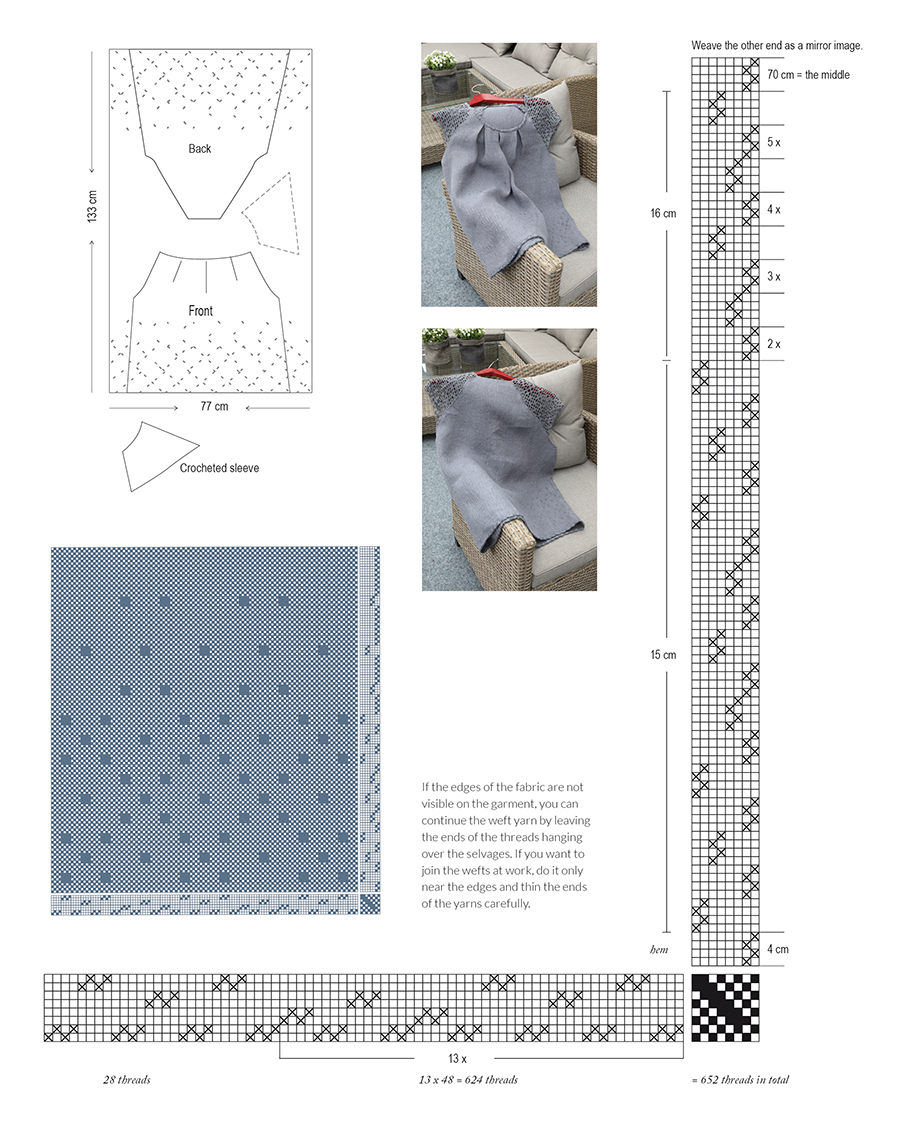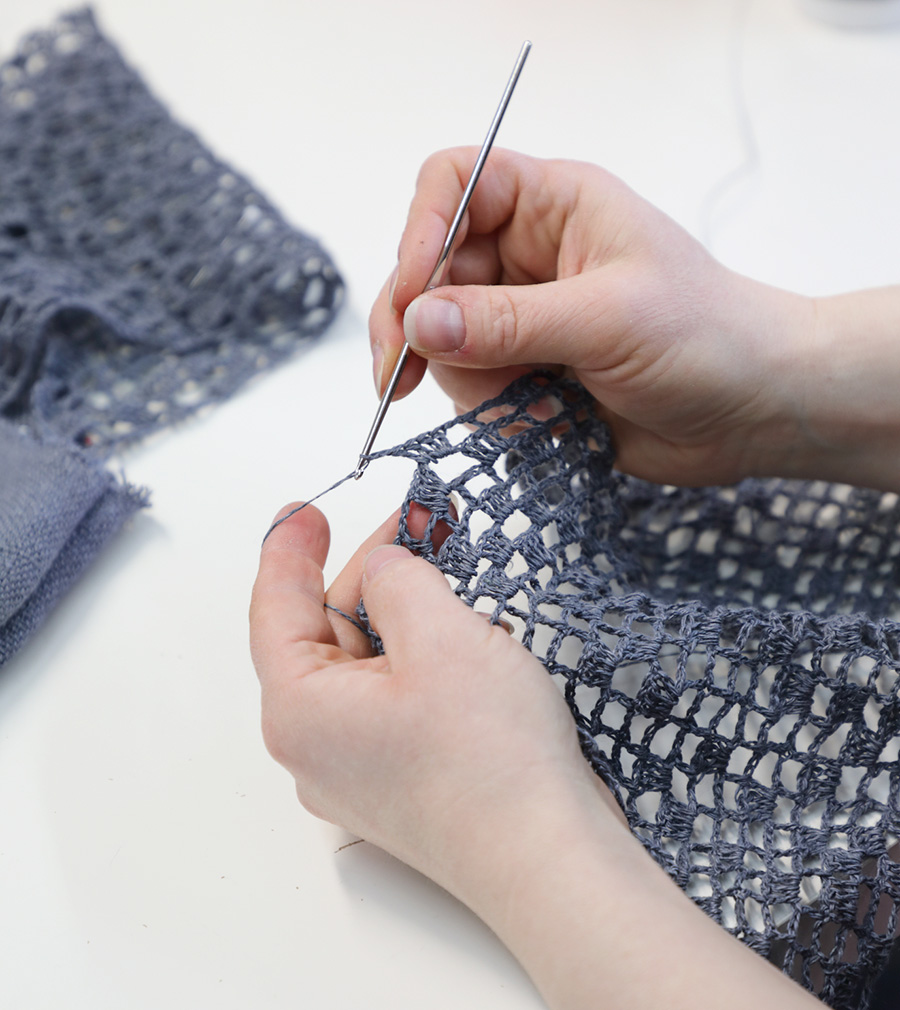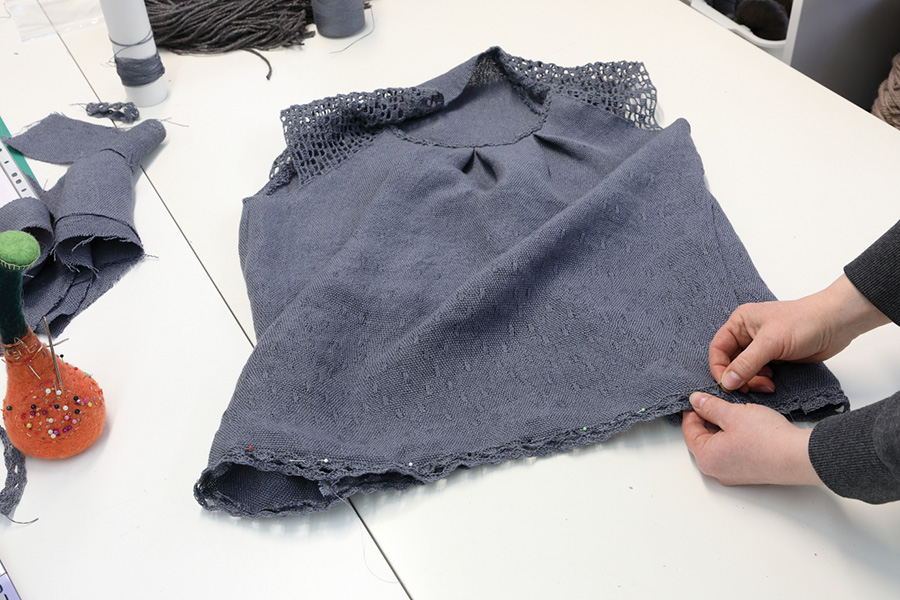The handwoven fabric brings with it opportunities that you will not be able to fulfill with industrial manufactured fabric. You can weave the fabric in looms, and in addition, knit and crochet parts of the garment with the same yarns. For this summer blouse, we wove the fabric for the front and back pieces and crocheted the sleeves from the same thread. In addition, we finished the hem and neckline with a crocheted ribbon.
Also play with pattern motifs! For example, place different motifs on the sleeve and hem. In this blouse, the dotted pattern is clear and complete near the hemline but becomes less dense as you go up from the hem. In addition, you can use colors creatively. For example, weave fabric of a different color into the hem or pockets.
| The warp | Line linen 16/2, tex 103×2, 1 kg = n. 4900 m, Filona, color 19 blue-gray |
| Warp | width 81,5 cm the sett 8 ends/cm number of warp ends 652 length 2,70 m amount of warp yarn needed 360 g |
| Reed | 2 per dent in a 40-dent reed (metric) |
| Structure | Plain weave, Spot weave |
Wind the warp of plied linen yarn with only one end at a time to a warping mill so the warp threads don’t twist together.
AMOUNT OF WEFT YARN NEEDET
Line linen 16/2, tex 103×2, 1 kg = approx. 4900 m, Filona, Lappajärven värjäämö Oy
colour 19 blue-gray 120 g


Linen fabric for summer blouse
Make your own or find your favorite blouse design and draw the sewing patterns. Calculate the required warp width and length and remember to add the shrinkage of the fabric in the calculations. It is generally better to have a little too much fabric than too little. This fabric shrank by 5% in length and width. The width of this warp is sufficient for a blouse of approx. 38-40 European sizes / 10-12 UK sizes / 6-8 USA sizes. Increase the width by increasing the number of the repeats in the threading. Each repeat is 48 yarns = 6 cm.
WEAVING INSTRUCTIONS
Weave 140 cm according to the treadling instructions. The patterned structure is placed on the hemlines. The fabric has been measured slightly loosely. The sett is 5,5 picks/cm. The fabric size woven was 81 x 138 cm and off the loom 77 x 133 cm.
FINISHING
Sew a 3-step zigzag at the ends of the fabric. Wash by hand in warm water, gentle soap. Lay flat until nearly dry. Press or steam the fabric through an ironing cloth. Sew a 3-step zigzag stitch on the edges of the pieces before cutting off.
Sew pleats and side seams. Turn 0.5 cm to the reverse side at the neck opening on the back piece and sew by hand. Turn 0.5 cm to the reverse side at the sleeve position on the back and front piece and sew by hand.

Crocheting
Crochet the sleeve pieces from the same thread from which the fabric is woven. Crochet lace ribbons of the neckline and hem from the same thread.
– Crochet hook No 2.
Use a simple checkerboard stitch pattern with chain stitches and double crochets. Fill empty boxes randomly with double crochets.
Start at the sleeve end. Crochet the number of chain stitches required for the sleeve end width.
Round 1: *4 double crochets, 2 chain stitch, skip 2 stitches (= blank box) * Repeat * – * Round 2 and forward: Crochet blank boxes and filled 4 double crochet boxes in a random order. Decrease at the edges according to the sleeve pattern. Finally, make single crochet stitches on the neckline.
Crochet a ribbon for the hem and neckline with shell stitches. Make two rounds of shells. The neckline has lace ribbon only on the edge of the front piece. Crochet the lace of the hem in two parts, making it easier to adjust the length.
Sew the sleeves closed with short, invisible stitches. The woven fabric is left on top of the crocheted fabric. Fold the edges of the crochet lace ribbon against each other. Place the fabric between the folded ribbon. Pin and baste. Sew the ribbon by hand first on the right side and then on the reverse side. Iron the seams open on the reverse side. Lightly iron the pleats on the neckline.
N.B! Always iron the linen fabric through an ironing cloth. Direct contact with a hot iron can burn the surface of the linen fabric brown.





